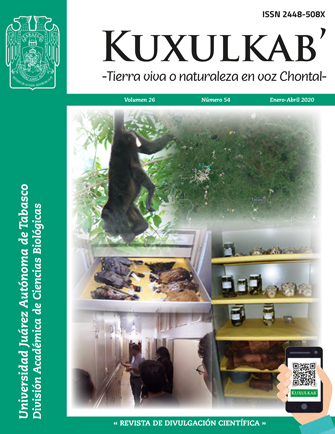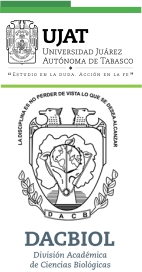«ÉRAMOS MUCHOS Y PARIÓ LA MONA»: DIETA DE Alouatta pigra EN CONDICIONES DE FRAGMENTACIÓN EN BALANCÁN, TABASCO
DOI:
https://doi.org/10.19136/kuxulkab.a26n54.3208Keywords:
Primates, Alimentación, Hábitat, México. | Primates, Feeding, Habitat, Mexico.Abstract
Los monos aulladores negros o saraguatos negros ('Alouatta pigra') constituyen una de las tres especies de primates silvestres mexicanos. Sin embargo, a pesar de que se ha documentado su gran flexibilidad conductual para adaptarse a diferentes ambientes, se tienen evidencias del impacto que tiene la disponibilidad del alimento y características de la vegetación en el éxito del aprovechamiento del hábitat que ocupen. A fin de evaluar de qué manera esta especie se adapta y selecciona su dieta dentro de un hábitat con fragmentación extrema, se realizaron observaciones conductuales. Así se pudo conocer las especies vegetales consumidas por dos grupos de saraguatos negros en dos sitios con distintas características y limitado espacio arbóreo.Downloads
References
Amato, K.R.; Leigh, S.R.; Kent, A.; Mackie, R.I.; Yeoman, C.J.; Stumpf, R.M.; Wilson, B.A.; Nelson, K.E, White; B.A. & Garber, P.A. (2014). The role of gut microbes in satisfying the nutritional demands of adult and juvenile wild, black howler monkeys ('Alouatta pigra'). American Journal of Physical Anthropology, (155): 652-664. DOI «https://doi.org/10.1002/ajpa.22621»
Amato, K.R.; Leigh, S.R.; Kent, A.; Mackie, R.I.; Yeoman, C.J.; Stumpf, R.M.; Wilson, B.A.; Nelson, A.; White, B.A. & Garber, P.A. (2015). The gut microbiota appears to compensate for seasonal diet variation in the wild black howler monkey ('Alouatta pigra'). Microbial Ecology, (69): 434-443. DOI «https://doi.org/10.1007/s00248-014-0554-7»
Amato, K.R.; Yeoman, C.J.; Kent, A.; Righini, N.; Carbonero, F.; Estrada, A.; Gaskins, H.; Stumpf, R.M.; Yildirim, S.; Torralba, M.; Gillis, M.; Wilson, B.A.; Nelson, K.E., White, B.A. & Leigh, S.R. (2013). Habitat degradation impacts black howler monkey ('Alouatta pigra') gastrointestinal microbiomes. The International Society for Microbial Ecology Journal (ISME), (7): 1344-1353. Recovered from «https://www.nature.com/articles/ismej201316.pdf»
Anzures-Dadda, A. & Manson, R.H. (2007). Patch- and landscape-scale effects on howler monkey distribution and abundance in rainforest fragments. Animal Conservation, (10): 69-76. DOI «https://doi.org/10.1111/j.1469-1795.2006.00074.x»
Aristizabal, J.F. (2013). Estrategias de forrajeo y características nutricionales de la dieta del mono aullador negro ('Alouatta pigra') en un ambiente fragmentado; (Tesis de Maestría en Ciencias, publicada). Xalapa, Veracruz; México: Instituto de Ecología A.C. (INECOL).
Aristizabal, J.F.; Lévêque, L.; Chapman, C.A. & Serio-Silva, J.C. (2018). Impacts of temperature on behaviour of the mexican endangered black howler monkey 'Alouatta pigra' Lawrence, 1933 (Primates: Atelidae) in a fragmented landscape. Acta Zoológica Bulgarica, 70(3): 377-382. Recovered from «http://www.acta-zoologica-bulgarica.eu/downloads/acta-zoologica-bulgarica/2018/70-3-377-382.pdf»
Arroyo-Rodríguez, V. & Dias, P.A.D. (2010). Effects of habitat fragmentation and disturbance on howler monkeys: a review. American Journal of Primatology, (72): 1-16. DOI «https://doi.org/10.1002/ajp.20753»
Arroyo-Rodríguez, V. & Mandujano, S. (2006). Forest fragmentation modifies habitat quality for 'Alouatta palliata'. International Journal of Primatology, 27(4): 1079-1096. DOI«https://doi.org/10.1007/s10764-006-9061-0»
Arroyo-Rodríguez, V.; Mandujano, S.; Benítez-Malvido, J. & Cuende-Fanton, C. (2007). The influence of large tree density on howler monkey ('Alouatta palliata mexicana') presence in very small rain forest fragments. Biotropica, 39(6): 760-766. DOI «https://doi.org/10.1111/j.1744-7429.2007.00330.x»
Chapman, C.A. & Chapman, L.J. (2002). Foraging challenges of red colobus monkeys: influence of nutrients and secondary compounds. Comparative Biochemistry and Physiology Part A: Molecular and Integrative Physiology, 133(3): 861-875. DOI «https://doi.org/10.1016/S1095-6433(02)00209-X»
Caywood, J.; Cunningham, T. & Cant, J.G.H. (1979). Ecology and behavior of howler monkeys ('Alouatta pigra') at Tikal, Guatemala. American Journal of Physical Anthropology, 50(3): 426. Recovered from «https://eurekamag.com/research/028/147/028147944.php»
Chapman, C.A. (1990). Ecological constraints on group size in three species of neotropical primates. Folia Primatologica, (55): 1-9. DOI «https://doi.org/10.1159/000156492»
Coelho, A.M.; Bramblett, C.A.; Quick, L.B. & Bramblett, S.S. (1976). Resource availability and population density in primates: a socio-bioenergetic analysis of the energy budgets of Guatemalan howler and spider monkeys. Primates, 17(1): 63-80. DOI «https://doi.org/10.1007/BF02381567»
Cristóbal-Azkarate, J. & Arroyo-Rodríguez, V. (2007). Diet and activity pattern of howler monkeys ('Alouatta palliata') in Los Tuxtlas, Mexico: effects of habitat fragmentation and implications for conservation. American Journal Primatology, 69(9): 1013-1029. DOI «https://doi.org/10.1002/ajp.20420»
Dias, P.A.D. & Rangel-Negrín, A. (2015). Diets of howler monkeys. In: Kowalewski, M.; Garber, P.; Cortés-Ortiz, L.; Urbani, B. & Youlatos, D. (eds); Howler monkeys: behavior, ecology and conservation; (pp. 21-56). New York, NY; USA: Springer. DOI «https://doi.org/10.1007/978-1-4939-1960-4_2»
Estrada, A. & Coates-Estrada, R. (1996). Tropical rain forest fragmentation and wild populations of primates at Los Tuxtlas, México. International Journal of Primatology, 17(5): 759-783. Recovered from «https://www.uv.mx/personal/tcarmona/files/2010/08/estrada-y-coates-1996.pdf»
Fuchs, E.J.; Lobo, J.A. & Quesada, M. (2003). Effects of forest fragmentation and flowering phenology on the reproductive success and mating patterns on the tropical dry forest tree 'Pachira quinata'. Conservation Biology, 17(1): 149-157. DOI «https://doi.org/10.1046/j.1523-1739.2003.01140.x»
Gavazzi, A.J.; Cornick, L.A.; Markowitz, T.M.; Green, D. & Markowitz, H. (2008). Density, distribution, and home range of the black howler monkey ('Alouatta pigra') at Lamanai, Belize. Journal of Mammalogy, 89(5): 1105-1112. DOI «https://doi.org/10.1644/07-MAMM-A-063.1»
Gilbert, K.A. (2003). Primates and fragmentation of the Amazon forest. In: Marsh, L.K. (ed.); Primates in fragments: ecology and conservation; (pp. 145-147). New York, NY.; USA: Kluwer Academic/Plenum Press.
Hernández-Rodríguez, D.; Vásquez-Aguilar, A.A.; Serio-Silva, J.C.; Rebollar, E.A. & Azaola-Espinosa, A. (2019). Molecular detection of 'Bifidobacterium spp.' in faeces of black howler monkeys ('Alouatta pigra'). Journal of Medical Primatology, 48(2): 99-105. DOI «https://doi.org/10.1111/jmp.12395»
Hill, J.L. & Curran, P.J. (2003). Area, shape and isolation of tropical forest fragments: effects on tree species diversity and implications for conservation. Journal of Biogeography, 30(9): 1391-1403. DOI «https://doi.org/10.1046/j.1365-2699.2003.00930.x»
Holzapfel, W.H.; Haberer, P.; Geisen, R.; Björkroth, J. & Schillinger, U. (2001). Taxonomy and important features of probiotic microorganisms in food and nutrition. The American Journal of Clinical Nutrition; 73(2): 365s-373s. DOI «https://doi.org/10.1093/ajcn/73.2.365s»
Hume, I.D. (2002). Digestive strategies of mammals. Acta Zoologica Sinica, 48(1): 1-19. Recovered from «https://pdfs.semanticscholar.org/d516/b8b47acbc5b29ef6dba2c51c09b61f255265.pdf»
INEGI (Instituto Nacional de Estadística y Geografía). (2016). Anuario estadístico y geográfico de Tabasco; (p. 461). Aguascalientes, Aguascalientes; México: Instituto Nacional de Estadística y Geografía (INEGI); Gobierno del Estado de Tabasco. Recuperado de «http://internet.contenidos.inegi.org.mx/contenidos/Productos/prod_serv/contenidos/espanol/bvinegi/productos/nueva_estruc/anuarios_2016/702825084363.pdf»
Laurance, W.F.; Delamônica, P.; Laurance, S.G.; Vasconcelos, H.L. & Lovejoy, T.E. (2000). Rainforest fragmentation kills big trees. Nature, 404: 836. DOI «https://doi.org/10.1038/35009032»
Laurance, W.F.; Ferreira, L.V.; Rankin-de Merona, J.M.; Laurance, S.G.; Hutchings, R.W. & Lovejoy, T.E. (1998). Effects of forest fragmentation on recruitment patterns in Amazonian tree communities. Conservation Biology, 12(2): 460-464. DOI «https://doi.org/10.1111/j.1523-1739.1998.97175.x»
Marsh, L.K.; Cuarón, A.D.; Cortés-Ortiz, L.; Shedden, A.; Rodríguez-Luna, E. & de Grammont, P.C. (2008). 'Alouatta pigra', The IUCN Red List of Threatened Species 2008. United Kingdom: International Union for Conservation of Nature (IUCN). DOI «https://dx.doi.org/10.2305/IUCN.UK.2008.RLTS.T914A13094441.en»
Milton, K. & McBee, R.H. (1983). Rates of fermentative digestion in the howler monkey, 'Alouatta palliata' (Primates: Ceboidea). Comparative Biochemistry and Physiology, Part A: Physiology, 74(1): 29-31. DOI «https://doi.org/10.1016/0300-9629(83)90706-5»
Milton, K. (1980). The foraging strategy of howler monkeys: a study in primate economics. New York, NY; USA: Columbia University Press.
Nagy, K.A. & Milton, K. (1979). Energy metabolism and food consumption by wild howler monkeys ('Alouatta palliata'). Ecology, 60(3): 475-480 DOI «https://doi.org/10.2307/1936066»
Nakamura, N.; Amato, K.R.; Garber, P.; Estrada, A.; Mackie, R.I. & Gaskins, H.R. (2011). Analysis of the hidrogenotrophic microbiota of wild and captive black howler monkeys ('Alouatta pigra') in Palenque National Park, México. American Journal of Primatology, 73(9): 909-919. DOI «https://doi.org/10.1002/ajp.20961»
Ostro, L.E.T.; Silver, S.C.; Koontz, F.W.; Young, T.P. & Horwich, R.H. (1999). Ranging behavior of translocated and established groups of black howler monkeys 'Alouatta pigra' in Belize, Central America. Biological Conservation, 87(2): 181-190. DOI «https://doi.org/10.1016/S0006-3207(98)00061-5»
Pavelka, M.S.M. & Knopff, K.H. (2004). Diet and activity in black howler monkeys ('Alouatta pigra') in southern Belize: does degree of frugivory influence activity level? Primates, 45: 105-111. DOI «https://doi.org/10.1007/s10329-003-0072-6»
Pérez-Gil Salcido, R.; Jaramillo Monroy, F.; Muñiz Salcedo, A.M. & Torres Gómez, M.G. (1996). Proyecto de importancia económica de los vertebrados silvestres de México; (p. 215). México D.F.; México: Comisión Nacional para el Conocimiento y Uso de la Biodiversidad (CONABIO).
Pires, M.M.; Guimarães Jr, P.R.; Aráujo, M.S.; Giaretta, A.A.; Costa, J.C.L. & Dos Reis, S.F. (2011). The nested assembly of individual?resource networks. Journal of Animal Ecology, 80(4): 896-903. DOI «https://doi.org/10.1111/j.1365-2656.2011.01818.x»
Pozo-Montuy, G. & Serio-Silva, J.C. (2006). Comportamiento alimentario de monos aulladores negros ('Alouatta pigra' Lawrence, Cebidae) en hábitat fragmentado en Balancán, Tabasco, México. Acta Zoológica Mexicana (n.s.), 22(3): 53-66. Recuperado de «http://www.scielo.org.mx/pdf/azm/v22n3/v22n3a5.pdf»
Ramírez-Julián, R. (2010). Respuestas conductuales de monos aulladores negros 'Alouatta pigra', viviendo en remanentes de vegetación entre pastizales, Balancán, Tabasco, México; (Tesis de Maestría en Ciencias, publicado). Xalapa, Veracruz; México. Instituto de Ecología A.C. (INECOL).
Sánchez-Garzón, N.X. (2016). Redes de interacción entre monos aulladores negros ('Alouatta pigra') y plantas para su alimentación y descanso diurno en Tabasco, México; (Tesis de Maestría en Ciencias, publicada). Xalapa, Veracruz; México. Instituto de Ecología A.C. (INECOL).
Saunders, D.A.; Hobbs, R.J. & Margules, C.R. (1991). Biological consequences of ecosystem fragmentation: a review. Conservation Biology, 5(1): 18-32. Recovered from «https://www.fs.fed.us/rm/pubs/rmrs_gtr292/1991_saunders.pdf»
Schlichte, H.J. (1978). A preliminary report on the habitat utilization of a group of howler monkeys ('Alouatta villosa pigra') in the National Park of Tikal, Guatemala. In: Montgomery, G.G. (ed.); Ecology of arboreal folivores; (pp. 551-559). Washington, D.C.; USA: Smithsonian Institution Press.
Silver, S.C.; Ostro, L.E.T.; Yeager, C.P. & Dierenfeld, E.S. (2000). Phytochemical and mineral components of foods consumed by black howler monkeys ('Alouatta pigra') at two sites in Belize. Zoobiology, 19(2): 95-109. DOI «https://doi.org/10.1002/1098-2361(2000)19:2<95::AID-ZOO1>3.0.CO;2-D»
Silver, S.C.; Ostro, L.E.T.; Yeager, C.P. & Horwich, R. (1998). Feeding ecology of the black howler monkey ('Alouatta pigra') in Northern Belize. American Journal Primatology, 45(3): 263-279. DOI «https://doi.org/10.1002/(SICI)1098-2345(1998)45:3<263::AID-AJP3>3.0.CO;2-U»
Stevenson, P.R. (2000). Seed dispersal by woolly monkeys ('Lagothrix lagotricha') at Tinigua National Park, Colombia: dispersal distance, germination rates, and dispersal quantity. American Journal of Primatology, 50(4): 275-289. DOI «https://doi.org/10.1002/(SICI)1098-2345(200004)50:4<275::AID-AJP4>3.0.CO;2-K»
Worman, C.O. & Chapman, C.A. (2005). Seasonal variation in the quality of a tropical ripe fruit and the response of three frugivores. Journal of Tropical Ecology, 21: 689-69. DOI «https://doi.org/10.1017/S0266467405002725»
Downloads
Published
Issue
Section
License
Los autores que publiquen en Kuxulkab' aceptan las siguientes condiciones como política de acceso abierto:
1. Que conservan los derechos de autor y ceden a la revista el derecho de la primera publicación, con el trabajo registrado con la licencia de atribucion de "Creative Commons", que permite a terceros utilizar lo publicado siempre que mencionen la autoría del trabajo y a la primera publicación en esta revista.
2. El autor puede realizar otros acuerdos contractuales independientes o adicionales para la distribución no exclusiva de la versión del artículo publicado en esta revista, como por ejemplo incluirlo en un repositorio institucional o publicarlo en un libro, siempre que se indique claramente que el trabajo se publicó por primera vez en esta revista.












